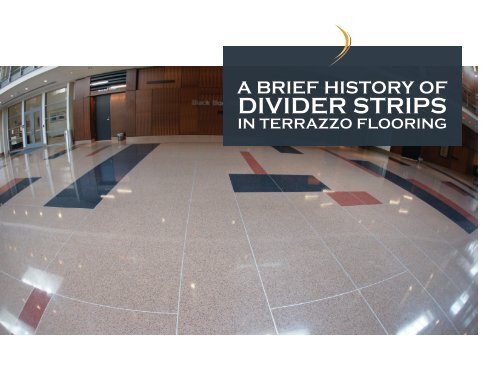DIVIDER STRIPS
2jTVqpb
2jTVqpb
You also want an ePaper? Increase the reach of your titles
YUMPU automatically turns print PDFs into web optimized ePapers that Google loves.
A BRIEF HISTORY OF<br />
<strong>DIVIDER</strong> <strong>STRIPS</strong><br />
IN TERRAZZO FLOORING
Doyle Dickerson Terrazzo is a terrazzo contractor in Charlotte,<br />
North Carolina. We are dedicated to honing the craft of terrazzo,<br />
providing a floor that will last for generations. This booklet<br />
features a brief history on divider strips, its purpose in terrazzo<br />
flooring, and installation photos displaying how divider strips can<br />
help create a flooring design only limited to your imagination.
Purpose of a Divider Strip<br />
During a terrazzo installation, the divider strips are placed in the<br />
terrazzo as a means of separating epoxy resin colors and act as a<br />
control Divider strips joint, are which placed reduces in terrazzo the as a means amount of separating of cracks epoxy in resin the flooring. colors and<br />
act as a control joint, which reduces the amount of cracking in the surface.
TIMELINE<br />
1700s<br />
Like many great imports coming to<br />
America, terrazzo soon followed.<br />
Gifted craftsmen started paving the<br />
way for terrazzo to become a staple<br />
in the flooring industry for years to<br />
come. With the advancement in<br />
installation methods, wood strips<br />
were introduced to divide different<br />
marble colors.<br />
1920s<br />
Wooden strips were soon replaced<br />
with brass divider strips.<br />
1930s<br />
White metal strips were developed.<br />
1940s<br />
During the World War II era, plastic<br />
strips were developed as metal<br />
became a necessity during this<br />
period to build tanks, ships, planes<br />
and weapons.<br />
Aluminum Divider Strips<br />
World War II Propaganda
TIMELINE<br />
2010s<br />
Currently, there is wide range of<br />
materials being used as divider strips<br />
today. Most divider strips are made<br />
from zinc, aluminum, brass, stainless<br />
steel and plastics.<br />
Installers can cut divider strips at a<br />
construction site or use a waterjet<br />
machine to create a customized<br />
terrazzo design out of metals like<br />
aluminum, zinc or brass.<br />
Check out some of these divider<br />
strip layouts:
Types of Divider Strips<br />
a. Standard Divider Strip with Anchoring Device<br />
This strip is available in white alloy of zinc or brass<br />
and 14,16, or B & S gauge. It is extensively used in<br />
Sand cushion, bonded, and other structural types of<br />
cementitious types of terrazzo.<br />
b. Heavy Top Divider Strip with Anchoring Device<br />
This strip is available in white alloy of zinc or galvanized<br />
steel bottom section. Top section available in white<br />
alloy of zinc or brass and width of top section is 1/8”,<br />
1/4”, 3/8” or 1/2”
THANKS FOR VIEWING<br />
Doyle Dickerson Terrazzo<br />
1709 University Commercial Place<br />
Charlotte, North Carolina 28213<br />
USA<br />
Tel: (704) 921-4940<br />
Fax: (704) 921-4941<br />
info@doyledickersonterrazzo.com<br />
doyledickersonterrazzo.com<br />
©2016 Doyle Dickerson Terrazzo, Inc.


